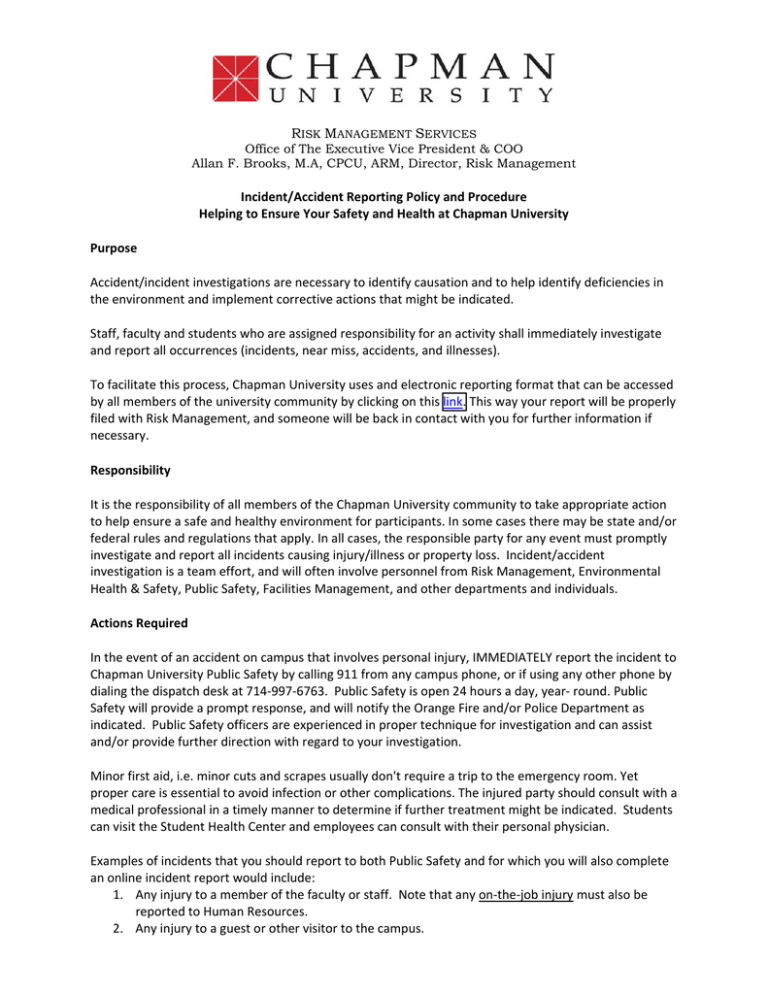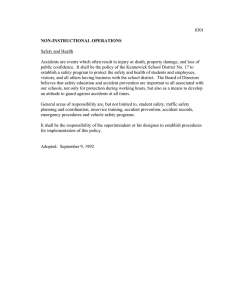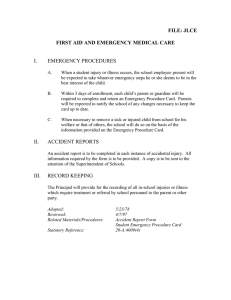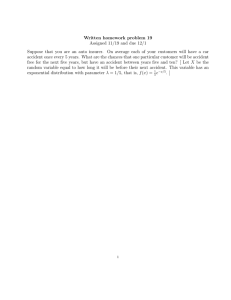
RISK MANAGEMENT SERVICES
Office of The Executive Vice President & COO
Allan F. Brooks, M.A, CPCU, ARM, Director, Risk Management
Incident/Accident Reporting Policy and Procedure Helping to Ensure Your Safety and Health at Chapman University Purpose Accident/incident investigations are necessary to identify causation and to help identify deficiencies in the environment and implement corrective actions that might be indicated. Staff, faculty and students who are assigned responsibility for an activity shall immediately investigate and report all occurrences (incidents, near miss, accidents, and illnesses). To facilitate this process, Chapman University uses and electronic reporting format that can be accessed by all members of the university community by clicking on this link. This way your report will be properly filed with Risk Management, and someone will be back in contact with you for further information if necessary. Responsibility It is the responsibility of all members of the Chapman University community to take appropriate action to help ensure a safe and healthy environment for participants. In some cases there may be state and/or federal rules and regulations that apply. In all cases, the responsible party for any event must promptly investigate and report all incidents causing injury/illness or property loss. Incident/accident investigation is a team effort, and will often involve personnel from Risk Management, Environmental Health & Safety, Public Safety, Facilities Management, and other departments and individuals. Actions Required In the event of an accident on campus that involves personal injury, IMMEDIATELY report the incident to Chapman University Public Safety by calling 911 from any campus phone, or if using any other phone by dialing the dispatch desk at 714‐997‐6763. Public Safety is open 24 hours a day, year‐ round. Public Safety will provide a prompt response, and will notify the Orange Fire and/or Police Department as indicated. Public Safety officers are experienced in proper technique for investigation and can assist and/or provide further direction with regard to your investigation. Minor first aid, i.e. minor cuts and scrapes usually don't require a trip to the emergency room. Yet proper care is essential to avoid infection or other complications. The injured party should consult with a medical professional in a timely manner to determine if further treatment might be indicated. Students can visit the Student Health Center and employees can consult with their personal physician. Examples of incidents that you should report to both Public Safety and for which you will also complete an online incident report would include: 1. Any injury to a member of the faculty or staff. Note that any on‐the‐job injury must also be reported to Human Resources. 2. Any injury to a guest or other visitor to the campus. RISK MANAGEMENT SERVICES
Office of The Executive Vice President & COO
Allan F. Brooks, M.A, CPCU, ARM, Director, Risk Management
3. Any injury to a student, especially if it occurs in a lab, workshop, classroom, or otherwise on campus. 4. Also, we would like you to report any motor vehicle accident on or off campus involving university personnel and/or property damage. 5. Or any other instance of property damage, theft, or mysterious disappearance, Departmental Support Activity and work supervisors can help improve accident/incident reporting in several ways: 1. Train participants to report all incidents 2. Take action on all incidents immediately 3. Emphasize the importance of reporting incidents in regular meetings with participants. A successful accident/incident investigation program contains standard investigation techniques or steps. The accident investigation process involves the following steps:
Report the incident to Public Safety, as indicated, then follow‐up by timely submission of your electronic report to Risk Management. Provide first aid and medical care to injured person(s) and prevent further injuries or damage Control hazards/secure accident site Investigate the accident, including interview of participants and witnesses Identify the causes Report the findings Develop a plan for corrective action Implement the plan Evaluate the effectiveness of the corrective action Make changes for continuous improvement As little time as possible should be lost between the moment of an accident or near miss and the beginning of the investigation. In this way, one is most likely to be able to observe the conditions as they were at the time, prevent disturbance of evidence, and identify witnesses. The tools that members of the investigating team may need (pencil, paper, camera, tape measure, etc.) should be immediately available so that no time is wasted. WHY DO WE INVESTIGATE INCIDENTS? Prevention is the purpose of an investigation. An incident investigation should: determine what actually happened, determine the cause or causes of the incident, identify any unsafe conditions, acts or procedures, help management to identify practical corrective actions, RISK MANAGEMENT SERVICES
Office of The Executive Vice President & COO
Allan F. Brooks, M.A, CPCU, ARM, Director, Risk Management
determines whether due diligence was observed, show the commitment of management that an adequate investigation system is in place. The purpose of these activities is not to find fault or lay blame, but rather to identify the basic causes of incidents so that controls can be put in place to prevent further occurrences. Information from the investigation should be put on the record, but not used to discipline anyone. This policy encourages witnesses to tell investigators everything they know. INCIDENT CAUSATION Incidents usually result from unsafe acts and conditions. These unsafe acts and conditions often arise because of defects in the safety program. A safety program by way of policies and procedures for organizing and performing activities defines the safe standards. Without a safety program or with a non‐
functional program, persons must devise their own safety and health standards. Much is then dependent on an individual’s experience, training, knowledge and will to apply safety and health standards on the job. Incident causes are usually broken down into: The direct cause: What was the direct cause of the incident? (What caused the injury?) The indirect cause: What were the root or hidden causes that led to the incident? (What caused the incident?) The 5 Ws of a Successful Interview The fundamentals of basic interviewing techniques follow the 5 Ws: Who, What, When, Where and Why. Add to that a line of questioning to assess How. Ask the interviewee to describe what happened by answering these questions. 1. WHO: Who was involved? In addition to the victim, identify any witnesses. Determine the role of each person as relates to the event and the incident. 2. WHAT: Identify exactly what happened, step‐by‐step. You should carefully interview each witness, preferably separately so as to not unduly influence ones response. 3. WHEN: Identify exactly when the incident happened. What was the exact time‐of‐ day? Identify the weather conditions, lighting, etc. 4. WHERE: Provide exact details as to location. Where there any hazardous conditions present? Were there elements of the environment that might have contributed to the accident or delayed emergency response? 5. WHY: Identify the causal elements that connect to the incident. Was there a lack of safety training? Where individuals acting in a manner that was beyond their level of training or experience? Where RISK MANAGEMENT SERVICES
Office of The Executive Vice President & COO
Allan F. Brooks, M.A, CPCU, ARM, Director, Risk Management
they wearing prescribed safety apparel? Where there other factors, including other persons that might have contributed to the incident? 6. HOW: Ask questions to identify how the incident happened and how it might have been prevented. Were all involved parties following policies and procedures? How was the emergency response initiated? Did it operate quickly and smoothly, according to Plan? 7. PHOTOS: Take photos of the site of the incident, from several different perspectives. Identify any conditions that might have contributed to the incident and photograph that area. Sample Witness Interview Questions
What are your name, address, and phone number?
What is your duty station and position?
What is your technical background or set of skills?
How are you connected with others involved in the accident?
When did you see the accident happen?
What attracted your attention to the accident?
When you first saw the accident, where was the vehicle or equipment? Where was the individual involved in the accident?
What was the direction of travel of the vehicle or equipment involved in the accident? Where was the final resting place of the vehicle or equipment? (Have the witness draw a diagram, if appropriate.)
Were any other witnesses around? Do you know the names of other witnesses?
Do you wear glasses or other corrective lenses? Do you wear a hearing aid? What type? Were you wearing your glasses or hearing aid?
Was proper personal protective equipment in use in connection with the task being performed? Exactly what personal protective wear was being used? Did the victim’s underlying clothing in any way contribute to the incident/accident or fail to protect them from injury?
Determine if there are Standard Operating Procedures (SOP’s) that are published for the work being performed, and if they were being followed for all persons involved.
Were persons performing the task(s) properly trained and properly supervised?
Would you like to provide any additional information? Other Questions: Contact Allan F. Brooks, CPCU, ARM, the Chapman University Director, Risk Management at 714‐532‐7794 or abrooks@chapman.edu RISK MANAGEMENT SERVICES
Office of The Executive Vice President & COO
Allan F. Brooks, M.A, CPCU, ARM, Director, Risk Management
HEINRICH’S THEORY OF ACCIDENT CAUSATION
FURTHER BACKGROUND - UNDERSTANDING ACCIDENT PREVENTION
Accidents are usually complex. An accident may have 10 or more events that can be causes. A detailed analysis of an accident will normally reveal three cause levels: basic, indirect, and direct. At the lowest level, an accident results only when a person or object receives an amount of energy or hazardous material that cannot be absorbed safely. This energy or hazardous material is the DIRECT CAUSE of the accident. The direct cause is usually the result of one or more unsafe acts or unsafe conditions, or both. Unsafe acts and conditions are the INDIRECT CAUSES or symptoms. In turn, indirect causes are usually traceable to poor management policies and decisions, or to personal or environmental factors. These are the BASIC CAUSES. In spite of their complexity, most accidents, per noted Industrial Safety Engineer H.W. Heinrich* are preventable by eliminating one or more causes. Accident investigations determine not only what happened, but also how and why. The information gained from these investigations can prevent recurrence of similar or perhaps more disastrous accidents. Accident investigators are interested in each event as well as in the sequence of events that led to an accident. The accident type is also important to the investigator. The recurrence of accidents of a particular type or those with common causes shows areas needing special accident prevention emphasis. A detailed analysis of an accident will normally reveal three cause levels: basic, indirect, and direct. * Henrich’s Theory of Accident Causation: This theory was initially proposed by H.W. Heinrich, a leading industrial engineer in the 1920’s an even today remains and important tool in studying and preventing accidents. From the UE Toolbox
Checklist for Investigating Accidents Causing
Personal Injury
This checklist is designed for use by employees who investigate any type of accident that occurs
on campus or school grounds resulting in personal injury. United Educators has found that
good investigation practices can significantly reduce the chance of litigation or strengthen the
institution’s defense when litigation does occur. Not all the steps outlined in the checklist will apply
to every situation; and the checklist should be adapted as appropriate for use at your institution.
As a rule, the first step after any accident should be immediately obtaining medical assistance for
injured parties and calling appropriate authorities, such as police or fire responders. Institutions
should conduct their investigations and document the conditions at the time of an accident
before making any repairs or changes. In addition, investigators should aim to determine the
facts surrounding the accident rather than the accident’s cause or who is to blame. In doing so,
it is important to avoid speculation, be as objective as possible, and focus on gathering evidence
instead of drawing conclusions.
I. Investigating the Accident Scene and Circumstances
A. All Accidents
Immediate Actions at the Scene
1. Secure the scene and prevent unauthorized access during the investigation.
2. Determine the precise location of the accident.
3. Take measurements at the accident scene.
4. Diagram or sketch the scene.
5. Take photographs or video.
■■ Include a measuring tape or other device in photographs to provide
perspective
■■ Include images of the victim and witnesses indicating the accident location
6. Take samples, or document presence, of any unusual substances or fluids, such
as water on the floor.
7. Collect or document the presence of any foreign objects.
8. If the accident occurred outdoors, document weather conditions.
9. Document footing and lighting conditions.
Completed?
Further Steps
From the UE Toolbox | Checklist for Investigating Accidents 2
A. All Accidents (continued)
Completed?
Further Steps
Completed?
Further Steps
10. Document any unusual sound or noise conditions.
11. Determine the number of people who were present, especially if crowded
conditions may have contributed to the accident.
12. If the accident occurred outdoors, document the type of ground surface, such
as grass, artificial turf, or gravel.
13. If the accident occurred indoors, document the type of floor surface, such as
wood, tile, or concrete.
14. Document any surface covering on the ground or floor, such as carpet, mats, or tarps.
15. Document whether the surface was level or sloped.
16. Document any apparent defects in the ground or floor, such as broken or
uneven concrete, warped wood, or torn or loose vinyl.
17. If the accident involved stairs, determine whether a handrail and anti-slip
strips were present and in good repair and note the condition of the risers.
Follow-Up Investigation
18. For accidents occurring indoors, document when the floor was last swept/
cleaned/waxed/mopped, and whether any “wet floor” signs were posted if
required.
19. If defects exist, determine how long they were present and whether there was
prior notice to the institution.
20. Examine any prior history of accidents at the location.
21. Examine any prior complaints made about the location.
22. Determine whether any recent repair work has been done at the location.
23. Determine whether regular or periodic inspections of the area were required
and, if so, were conducted.
B. Specific Types of Accidents
1. If the accident involved athletics:
■■ Determine whether participants were using protective equipment, such as
helmets and pads
■■ Determine whether equipment was in good operating condition
■■ Examine whether participants followed any recommended practices, such
as using spotters or having coaches or trainers present ■■ Investigate whether coaches or others in authority took actions to increase
or decrease the risk of injury (e.g., obtain team practice schedules and
videos of practices)
2. If equipment or tools were involved in the accident, determine: ■■ Their operational condition
■■ Whether they were used properly and with needed authorization
■■ Whether users received appropriate training
3. If the accident resulted in a fire or explosion, determine:
■■ Whether chemicals or other hazardous substances were being used
www.ue.org
From the UE Toolbox | Checklist for Investigating Accidents 3
B. Specific Types of Accidents (continued)
Completed?
Further Steps
Whether any chemicals or hazardous substances were used properly, with
authorization, and after required training
■■ Whether sprinklers were present and operational
4. In the case of a fall from a building, determine the:
■■ Condition of windows, screens, and any crash bars
■■ Condition of balconies, porches, decks, or fire escapes , including stairs and
guardrails
■■ Condition of the roof
■■ Ease of access to the windows or roof
■■ Presence and condition of barriers limiting access, such as locked doors
■■ Presence of warning signs if access is limited
5. If the accident involved one or more vehicles: ■■ For the accident location, determine:
• Road conditions when the accident occurred • Weather conditions when the accident occurred
• Other factors bearing on visibility
• The proximity and role of traffic signals/lights, signs, intersections,
crosswalks, or traffic patterns, such as circles or roundabouts
■■ For each vehicle involved, determine:
• Its speed at the time of the accident
• The vehicle’s operating condition, including tires, brakes, lights, turn
signals, wipers, and muffler
• The operating condition of protective devices, including seat belts and
air bags
• Information relating to the vehicle’s load, such as weight limitations
and authorized cargo type or capacity
• The date of its last service and any maintenance problems
• Whether the vehicle is owned/leased by the institution or the
individual driver
■■ For each driver involved, obtain information about:
• His or her driver’s license and insurance • How long the driver has been licensed
• Compliance with traffic safety laws and rules at time of the accident
• The vehicle’s registration • Any passenger identification • The driver’s prior accident history
• The driver’s mental and emotional state before the accident
• Whether the driver was fatigued or distracted, such as by use of a cell phone or other electronic device
■■
www.ue.org
From the UE Toolbox | Checklist for Investigating Accidents 4
B. Specific Types of Accidents (continued)
Completed?
Further Steps
Completed?
Further Steps
Completed?
Further Steps
6. If the driver is an employee or volunteer of the institution, determine whether
he/she:
■■ Was working at the time of the accident ■■ Completed any required driver training or safety course
II.Dealing With Accident Parties and Witnesses
A. Identify all injured parties and witnesses
1. Interview injured parties separately from each other and from witnesses.
2. Document all injuries, both those observed and those described by the parties
or witnesses, as specifically as possible.
3. Determine the injured party’s physical position immediately before and after
the accident.
4. Determine whether the injured party had any disability or medical condition.
5. Establish whether the injured party wore, or needed, glasses/contact lenses or
hearing aids.
6. Establish whether the injured party used, or needed, a cane, walker, or other
device to assist mobility.
7. Document the type and condition of the injured party’s clothing and shoes.
8. Determine what items the injured party was carrying.
9. If the accident involved an employee on the job, check for compliance with
relevant work procedures and rules.
10. Determine whether the injured party has made past complaints or claims of
injury against the institution.
B. Interviews
All Interviews
1. For each injured party and witness, determine the individual’s:
■■ Identification (name, address, phone, email, age)
■■ Status (student, employee, volunteer, alumni, visitor)
■■ Reason for being at the accident location
■■ Familiarity with the location
2. Ask open-ended questions when possible, avoiding those that allow only “yes”
or “no” responses.
3. Obtain the individual’s account of the accident and follow up with specific
questions to cover:
■■ How the accident happened
■■ Whether anyone besides the injured party was involved in the accident
■■ The person’s prior knowledge of any defects, including warning signs, tape,
or barriers
www.ue.org
From the UE Toolbox | Checklist for Investigating Accidents 5
B. Interviews (continued)
Completed?
Further Steps
Use by anyone involved in the accident of electronic devices, such as
speaking/texting on a cell phone or using an MP3 player
3. Make short notes during the interview and detailed notes immediately
following it.
4. Request a sketch or diagram of the accident location and events.
5. Consider recording (video, audio, or both) the individual’s statement.
6. Request the individual’s written statement or completion of the institution’s form.
Injured Party Interviews
8. Document any refusal of medical treatment by the injured party.
9. Offer the injured party assistance in contacting family or friends.
10. Determine:
■■ Whether the injured party was alone or accompanied when the accident
occurred
■■ What the person was doing immediately before the accident
■■ What the person did immediately after the accident
■■ The person’s awareness of any witnesses to the accident
11. Ask whether the injured party consumed any alcohol, drugs, or medication
(prescription or otherwise) within 24 hours before the accident.
12. Include factual observations about the injured party’s condition, including any
corroborating evidence, such as “the injured party appeared intoxicated based
on a strong smell of alcohol, slurred speech, and difficulty walking.”
Witness Interviews
13. Determine whether the witness has a relationship to the injured party or was
simply a bystander.
14. If the witness was a bystander, establish what attracted his or her attention,
such as screaming or sound of impact.
15. Establish the witness’ exact location, relative to the injured party, at the time
of the accident.
16. Determine whether the witness overheard any statements by the injured party
or others involved in the accident.
17. Ask whether the witness has any knowledge of alcohol or drug use by the
injured party before the accident.
■■
Resources
■■ UE Roundtable, “Accident Investigations,” Nov. 16, 2004.
Resources
Audio
Education’s Own Insurance Company
The material appearing in this publication is presented in summary form and should not be considered legal advice. The use of any material
appearing in this publication does not establish that relevant legal requirements or best practices have been met.
Copyright © 2012 by United Educators Insurance, a Reciprocal Risk Retention Group. All rights reserved. Contents of this document are for
members of United Educators only. Permission to post this document electronically or to reprint must be obtained from United Educators.



